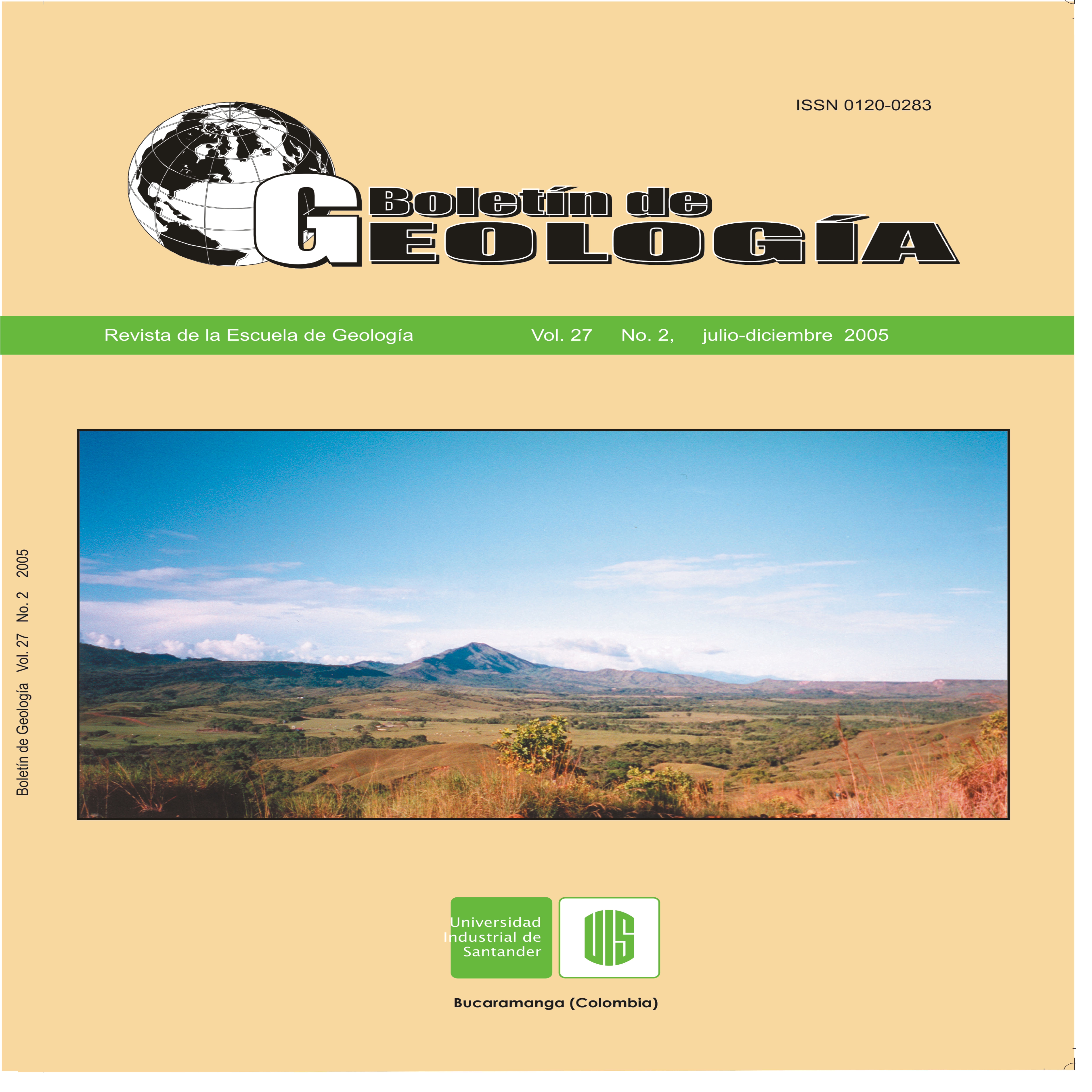SUSTITUCIONES CATIÓNICAS QUE GOBIERNAN LA QUÍMICA DEL ANFÍBOL EN METABASITAS DE LA FORMACIÓN SILGARÁ EN LA REGIÓN SUROCCIDENTAL DEL MACIZO DE SANTANDER
How to Cite
Abstract
Las paragénesis con presencia de anfíbol de las rocas metabásicas de la Formación Silgará en la región suroccidental del Macizo de Santander registran evidencia de metamorfismo prógrado. Análisis ópticos y de microsonda electrónica, junto con cálculos termobarométricos en estas rocas, muestran que la principal variación en anfíboles cálcicos es la sustitución simultánea de Al en el sitio T1 (AlIV) y Na+K en el sitio A de la estructura cristalina del anfíbol. AlIV es fuertemente dependiente de la temperatura, y esta dependencia enmascara cualquier efecto de la presión. Los cambios en la composición química del anfíbol cálcico son interpretados a traves de sustituciones acopladas, y reacciones con los minerales con los cuales coexiste durante un aumento en las condiciones de metamorfismo desde la facies esquisto verde hasta la facies anfibolita inferior, siendo circunstancias favorables que registran no solo las facies metamórficas alcanzadas por las rocas sino tambien las condiciones de P-T por las cuales estas fueron obtenidas.
Palabras claves: anfíbol, Silgará, metabasitas, sustitución, condiciones de metamorfismo
Downloads
References
Bence, A., and Albee, A. (1968). Empirical correctionfactors for the electron microanalysis of silicates andoxides. Journal of Geology, Vol. 76, pp. 382-403
Blundy, J., and Holland, T. (1990). Calcic Ca-amphiboleequilibria and a new Ca-amphibole plagioclasegeothermometer. Contributions to Mineralogy andPetrology, Vol. 104, pp. 208-224
Brown, E. (1977). The crossite content of Ca-amphiboleas a guide to pressure of metamorphism. Journal ofPetrology, Vol. 18, pp. 53-72
Castellanos, O. (1999). Estudio mineralógico y petrográficode la Formación Silgará en la Franja Pescadero-Aratoca(Santander). Tesis de Pregrado, Universidad Industrial deSantander, Bucaramanga (Colombia)
Deer, W.A., Howie, R.A., and Zussman, J. (1983) Rock-forming Minerals, Chain Silicates, Vol. 2, Wiley, NewYork, 379p
Dörr, W., Grösser, J., Rodriguez, G., and Kramm, U.(1995). Zircon U-Pb age of the Paramo Rico tonalite-granodiorite, Santander Massif (Cordillera Oriental,Colombia) and its geotectonic significance. Journal ofSouth American Earth Sciences, Vol. 8(2), pp.187-194
Ernst, W., and Liu, J. (1998). Experimental phase studyof Al- and Ti-contents of calcic Ca-amphibole in MORB– A semiquantitative thermobarometer. AmericanMineralogist, Vol. 83, pp. 952-969
Forero, A. (1990). The basement of the EasternCordillera, Colombia: An allochthonous terrane innorthwestern South America. Journal of South AmericanEarth Sciences, Vol. 3(23), pp. 141-151
García, C., y Castellanos O. (1998). Petrografía de laFormación Silgará en la Cordillera Oriental, Colombia. XCongreso Latinoamericano de Geología, Buenos Aires,Argentina, Memorias, Vol. 2, pp. 263-268
García, C., y Ríos, C. (1999). Metamorfismo ymetalogenia asociada del Macizo de Santander, CordilleraOriental, Colombia. Informe final Proyecto deInvestigación. Universidad Industrial de Santander-Colciencias, 191p
Gélvez, J., y Márquez, R. (2002). Caracterización texturaldel granate y de sus elementos de deformación asociados,y modelamiento de su historia de nucleación ycrecimiento en las rocas metapelíticas de la FormaciónSilgará en la región suroccidental del Macizo de Santander.Tesis de Pregrado, Universidad Industrial de Santander,Bucaramanga (Colombia)
Gilbert, M., Helz, R., Popp, R., and Spear, F. (1981).Experimental studies of amphibole stability. Rev. Mineral.,Vol. 9B, pp. 229-353
Goldsmith, R., Marvin, R., and Mehnert, H. (1971).Radiometric ages in the Santander Massif, easternCordillera, Colombian Andes. U.S. Geol. Survey Prof.Paper, Vol. 750-D, pp. D41-D49
Graham, C. (1974). Metabasite amphiboles of theScottish Dalradian. Contributions to Mineralogy andPetrology, Vol. 47, pp. 165-185.
Graham, C., and Powell, R. (1984). A garnet-hornblendegeothermometer: calibration, testing and application tothe Pelona Schist, Southern California. Journal ofMetamorphic Geology, Vol. 2, pp. 13-131
Hammarstrom, J., and Zen, E. (1992). Discussion ofBlundy and Holland’s (1990) “Calcic Ca-amphiboleequilibria and a new amphibole-plagioclasegeothermometer”. Contributions to Mineralogy andPetrology, Vol. 111, pp. 264-266
Hawthorne, F. (1983). Crystal chemistry of theamphiboles. Canadian Mineralogist, Vol. 21, pp. 174-481.Hey, M. (1954). A new review of the chlorites.Mineralogical Magazine, Vol. 25, pp. 277-292
Holland, T., and Blundy, J. (1994). Non-ideal interactionsin calcic amphiboles and their bearing on amphibole-plagioclase thermometry. Contributions to Mineralogy andPetrology, Vol. 116, pp. 433-447
Johnson, M., and Rutherford, M. (1989). Experimentalcalibration of the aluminum-in-hornblende gebarometerwith application to Long Valley Caldera (California)volcanic rocks. Geology, Vol. 17, pp. 837-841
Kawakatsu, K., and Yamaguchi, Y. (1987). Successivezoning of amphiboles during progressive oxidation in theDaito-Yakota granitic complex, San-in belt, southwestJapan. Geochimica et Cosmochimica Acta, Vol. 51, pp.535-540
Kohn, M., and Spear, F. (1989). Empirical calibration ofgeobarometers for the assemblagegarnet+hornblende+plagioclase+quartz. AmericanMineralogist, Vol. 74, pp. 77-84
